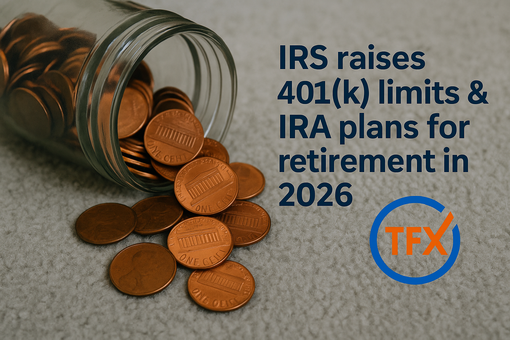IRS Tax Brackets and inflation adjustments 2023
The IRS has released the tax brackets and inflation adjustments for the 2023 tax year. In this article we’ll take a closer look at the new tax brackets (due before April 15, 2024) and find out all the details on how they will be affected by inflation.
Also read - Tax Brackets and Deductions 2022 (for taxes due in April 2023)
We here at TaxesForExpats have also come up with the method to calculate your income tax based on the top bracket that applies to you, and will also discuss here all the other changes for the upcoming tax year you should know about.
What are Tax Brackets?
Tax brackets are the ranges of income that are taxed at different rates by the federal government. The IRS adjusts these brackets each year to account for inflation. This is done so that taxpayers are not unfairly burdened by rising prices. The tax rate that you pay depends on which bracket your income falls into.
There are seven tax brackets in the United States: 10%, 12%, 22%, 24%, 32%, 35%, and 37%. The rate that you pay will be based on your taxable income. Taxable income is your total income after deductions and credits have been applied.
How Tax Brackets work
Your tax bracket is the rate you pay on the "last dollar" you earn; however, most of your income will likely be taxed at a lower rate. The marginal tax rate is the highest rate of tax that you will pay on your income.
For example, let's say that you are a single filer with a taxable income of $50,000. This puts you in the 22% tax bracket (see the table below); however, you will not pay a 22% tax on your entire income. Instead, you will pay 10% on the first $9,950 of your income, 12% on the next $30,050, and 22% on the last $10,000. This marginal tax rate is what determines your tax bracket.
To calculate your overall tax rate, known as the “effective tax rate”, you will need to divide your income into the portions that fall under each tax bracket.
There is a different tax rate for every bracket, and which one you use depends on your filing status: single filer, married filing jointly, married filing separately, or head of household.
The main changes in revenue procedure
The tax items of the greatest interest to most taxpayers for the 2023 tax year include the following dollar amounts:
1. The standard deduction is what allows you to reduce your taxable income.
- The tax year 2023's standard deduction for married couples filing jointly rises to $27,700, up $1,800 from last year.
- For single taxpayers and married individuals who file separately, the standard deduction will be $13,850 for 2023; an increase of $900 from the prior year.
- The standard deduction for heads of households will be $20,800 in 2023, which is an increase of $1,400 from the year before.
2. Marginal Rates: For 2023, the top tax rate for individual single taxpayers with incomes greater than $578,125 ($693,750 for married couples filing jointly) remains 37%.
The other rates are:
- 35% for incomes over $231,250 ($462,500 for married couples filing jointly);
- 32% for incomes over $182,100 ($364,200 for married couples filing jointly);
- 24% for incomes over $95,375 ($190,750 for married couples filing jointly);
- 22% for incomes over $44,725 ($89,450 for married couples filing jointly);
- 12% for incomes over $11,000 ($22,000 for married couples filing jointly); and
The lowest rate of 10% is for single individuals with incomes of $11,000 or below ($22,000 for married couples filing jointly).
Here's the pivot table of every single bracket and rate 2023 (for taxes due before April 15, 2024):
|
Rate |
Single Individual |
Married Filing Jointly, Surviving Spouse |
Married Filing Separately |
Head of Household |
| 10% | $0 to $11,000 | $0 to $22,000 | $0 to $11,000 | $0 to $15,700 |
| 12% | Over $11,000 to $44,725 | Over $22,000 to $89,450 | Over $11,000 to $44,725 | Over $15,700 to $59,850 |
| 22% | Over $44,725 to $95,375 | Over $89,450 to $190,750 | Over $44,725 to $95,375 | Over $59,850 to $95,350 |
| 24% | Over $95,375 to $182,100 | Over $190,750 to $364,200 | Over $95,375 to $182,100 | Over $95,350 to $182,100 |
| 32% | Over $182,100 to $231,250 | Over $364,200 to $462,500 | Over $182,100 to $231,250 | Over $182,100 to $231,250 |
| 35% | Over $231,250 to $578,125 | Over $462,500 to $693,750 | Over $231,250 to $346,875 | Over $231,251 to $578,100 |
| 37% | Over $578,120 | Over $693,750 | Over $346,875 | Over $578,100 |
3. Other Changes:
- For the 2023 tax year, the Alternative Minimum Tax exemption is $81,300. The phase out for this amount begins at $578,150 ($126,500 for married couples filing jointly). The exemption amount for the 2022 tax year is $75,900. It begins to phase out at $539,900 for individual filers and at $1,079,800 for married couples filing jointly.
- For those who have three or more qualifying children, the Earned Income Tax Credit amount will be $7,430 for the tax year 2023. This is up from $6,935 during the tax year 2022. The revenue procedure contains a table with the maximum amount of EITC for other categories, income thresholds, and phase-outs.
- The qualified transportation fringe benefit and the qualified parking monthly limitation for 2023 will be $300, an increase of $20 from the limit in 2022.
- The employee salary reduction for contributions to health flexible spending arrangements will be increased to $3,050 starting in 2023. The maximum amount that can be carried over for cafeteria plans is increasing from $610 to $650 for taxable years beginning in 2022.
- The Medical Savings Account annual deductible must be at least $2,650 and can be no more than $3,950 for the 2023 tax year. This is an increase of $200 and $250 respectively from the 2022 tax year. If you have self-only coverage, the maximum out-of-pocket expense amount will be $5,300, an increase of $350 from 2022.
For the 2023 tax year, for a family deductible coverage plan, the minimum amount has increased to $5,300 from $4,950 in 2022; however, there is a maximum limit of $7,900 set for 2023, which is an increase of 500 from what was allowed in 2022. The maximum out-of-pocket expense for family coverage will be $9,650 in 2023, an increase of $600 from the previous year.
- The foreign earned income exclusion for the tax year 2023 is set at $120,000, a value which has increased from the previous year's figure of $112,000.
- For descendants who die in 2023, the basic exclusion amount will be $12,920,000--an increase from the $12,060,000 excluded for those dying in 2022.
- For the 2023 calendar year, the annual exclusion amount for gifts increases to $17,000 from $16,000 in 2022.
- For the tax year 2023, the credit allowed for adoptions is up to $15,950 for qualified expenses. This maximum amount has increased from $14,890 in 2022.
Also - items remaining unaffected by indexing
According to the law, some items that were once adjusted for inflation are no longer being changed.
- For the 2023 tax year, the personal exemption remains at 0. The elimination of personal exemption was a provision in the Tax Cuts and Jobs Act.
- For the 2023 tax year, as well as the previous five years, there is no itemized deduction limitation in place.
- The Lifetime Learning Credit will decrease for joint tax filers who do not adjust their modified adjusted gross income for inflation in taxable years after December 31, 2020. Modified adjusted gross income in excess of $80,000 for single taxpayers and $160,000 for joint filers phases out the Lifetime Learning Credit.


